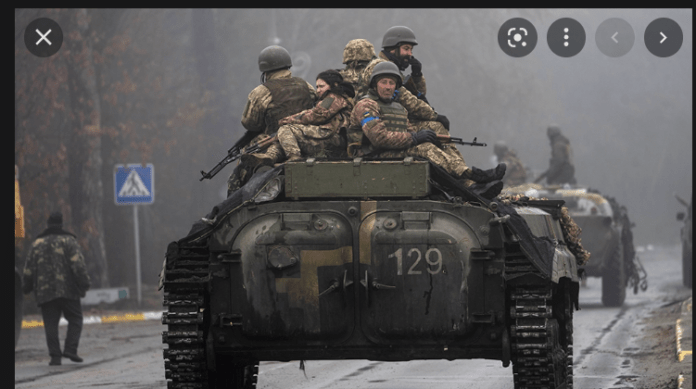Opinion by Robert A. Manning, Opinion Contributor – Yesterday 9:30 PM
Wars tend to take on a life of their own, with all sides in a cycle of action-reaction, each seeking to realize its theory of victory. As the war of attrition in Ukraine grinds on, there is an all-too familiar “mission creep” — a shift in U.S. goals from aiding Ukraine to defend and recover its sovereignty, to total victory and total defeat of Russian President Vladimir Putin and, as Secretary of Defense Lloyd Austin advised, “to weaken Russia.”
But citing the Chinese curse, my ex-boss, the late Secretary of State Colin Powell, often advised, “Be careful what you wish for, because you just might get it.” As Rep. Jason Crow (D-Colo.), echoing a popular view, put it while visiting Ukraine: The U.S. “is in this to win it.” And why not? Putin’s barbarism and Ukraine’s heroic resistance certainly merit it. But, for starters, there needs to be a recognition that there is indeed a shift in goals.
It may, indeed, be the right approach. But putting aside that the U.S. has chosen to fight this war vicariously, I have seen this sort of escalation too many times before, from Vietnam to Somalia and Libya. It rarely ends well.
One unappreciated problem is an asymmetry in goals. Ukraine needs an outcome that regains most or all of its sovereign territory and a functioning state. But Putin, whose military disaster has led him to define down his goals, only needs to control the Donbas in Eastern Ukraine and build a land bridge south to Crimea (or maybe Donbas would suffice), which he will annex and could call a ceasefire and pretend victory. The reality would likely be a protracted frozen conflict.
At the same time, Putin, who says Ukraine was never really a state, could destroy or block the vital port of Odessa and Kherson, which he already is blockading, leaving it landlocked, and bomb much of Ukraine’s infrastructure. He would then partition Ukraine, leaving its viability as a state in question.
Or there is the victory scenario, in which Ukrainian forces not only halt Putin’s offensive in the Donbas and push it back to the pre-Feb.24 invasion status quo, but fully drive Russian forces out of Ukraine, period. That would make Putin a cornered rat, one with nukes, even if deservedly so. Or in one conceivable scenario, as Kyiv mounted forces to retake the last piece, Crimea, Putin might install SS-26 nuclear-tipped tactical missiles and threaten to use them, as he considers it an attack on sovereign Russian territory.
Both scenarios would pose the risk of escalation. In the former, would U.S. or NATO forces escalate to push back Russian forces to prevent such a fait accompli? In the second scenario, how would U.S. or NATO forces respond if, for example, Putin fired a tactical nuke along the Polish border to disrupt NATO military aid to Ukraine? How would the U.S. or NATO respond to the Crimea-nuclear scenario mentioned above?
Biden’s reported recent comment that he would not send multiple rocket launchers to Ukraine “that could hit Russia” deepens the mystery.
But those are just the military issues. Already, unplugging Russia and disrupting Ukraine’s economy are wreaking global economic havoc. Europe is likely to plunge into recession and the U.S. also risks such a slowdown. Food crises are already beginning, as Ukraine and Russian wheat exports have halted.
From Sri Lanka and Somalia to Egypt, there are food riots and threats of famine. Fourteen nations on the Horn of Africa face starvation. And with regard to the global economy, already problematic debt crises in less developed nations are worsening due to slower growth and inflation. The International Monetary Fund has not been given additional resources to respond to potential debt defaults in many of some 80 developing nations from Argentina to Zimbabwe.
Ukraine has now become a war of grinding attrition. Serious diplomacy is unlikely until the military advantage tips on one direction or the other. But the economic pressures are mounting, additionally in Europe as it copes with some 6 million Ukrainian refugees and struggles to find ways to wean itself off Russian oil and gas.
Comments by European officials in recent weeks raise concerns of looming U.S.-EU fissures on the endgame in Ukraine. There is risk of division over key questions: how much to “weaken” and humiliate Putin (though Putin has caused much Russian self-humiliation already). Recent comments by former U.S. Secretary of State Henry Kissinger that Ukraine should give territory to Russia may reinforce European tendencies to seek compromise solutions.
While the decision about when and what to negotiate is a matter mostly for Ukraine to decide, external pressures on Kyiv may well be a growing factor. The economic havoc and European fears of having a giant North Korea next door, as well as growing fears of escalation, will be a fast growing factor in the decisionmaking of the U.S. and NATO as well as Kyiv.
Robert A. Manning is a senior fellow of the Scowcroft Center for Strategy and Security and its New American Engagement Initiative at the Atlantic Council. He was a senior counselor to the undersecretary of state for global affairs from 2001-04, a member of the U.S. Department of State policy planning staff from 2004-08 and on the National Intelligence Council strategic futures group from 2008-12. Follow him on Twitter @Rmanning4.




